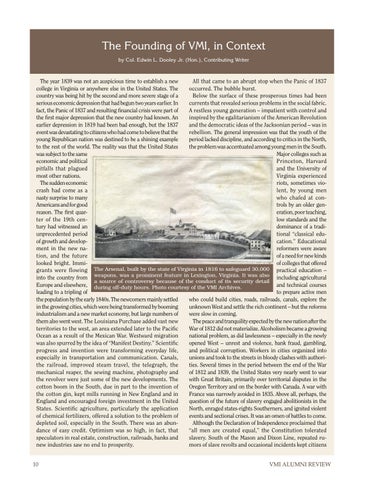The Founding of VMI, in Context by Col. Edwin L. Dooley Jr. (Hon.), Contributing Writer
The year 1839 was not an auspicious time to establish a new All that came to an abrupt stop when the Panic of 1837 college in Virginia or anywhere else in the United States. The occurred. The bubble burst. country was being hit by the second and more severe stage of a Below the surface of these prosperous times had been serious economic depression that had begun two years earlier. In currents that revealed serious problems in the social fabric. fact, the Panic of 1837 and resulting financial crisis were part of A restless young generation – impatient with control and the first major depression that the new country had known. An inspired by the egalitarianism of the American Revolution earlier depression in 1819 had been bad enough, but the 1837 and the democratic ideas of the Jacksonian period – was in event was devastating to citizens who had come to believe that the rebellion. The general impression was that the youth of the young Republican nation was destined to be a shining example period lacked discipline, and according to critics in the North, to the rest of the world. The reality was that the United States the problem was accentuated among young men in the South. was subject to the same Major colleges such as economic and political Princeton, Harvard pitfalls that plagued and the University of most other nations. Virginia experienced The sudden economic riots, sometimes viocrash had come as a lent, by young men nasty surprise to many who chafed at conAmericans and for good trols by an older genreason. The first quareration, poor teaching, ter of the 19th cenlow standards and the tury had witnessed an dominance of a tradiunprecedented period tional “classical eduof growth and developcation.” Educational ment in the new nareformers were aware tion, and the future of a need for new kinds looked bright. Immiof colleges that offered grants were flowing The Arsenal, built by the state of Virginia in 1816 to safeguard 30,000 practical education – into the country from weapons, was a prominent feature in Lexington, Virginia. It was also including agricultural a source of controversy because of the conduct of its security detail Europe and elsewhere, during off-duty hours. Photo courtesy of the VMI Archives. and technical courses leading to a tripling of to prepare active men the population by the early 1840s. The newcomers mainly settled who could build cities, roads, railroads, canals, explore the in the growing cities, which were being transformed by booming unknown West and settle the rich continent – but the reforms industrialism and a new market economy, but large numbers of were slow in coming. them also went west. The Louisiana Purchase added vast new The peace and tranquility expected by the new nation after the territories to the west, an area extended later to the Pacific War of 1812 did not materialize. Alcoholism became a growing Ocean as a result of the Mexican War. Westward migration national problem, as did lawlessness – especially in the newly was also spurred by the idea of “Manifest Destiny.” Scientific opened West – unrest and violence, bank fraud, gambling, progress and invention were transforming everyday life, and political corruption. Workers in cities organized into especially in transportation and communication. Canals, unions and took to the streets in bloody clashes with authorithe railroad, improved steam travel, the telegraph, the ties. Several times in the period between the end of the War mechanical reaper, the sewing machine, photography and of 1812 and 1839, the United States very nearly went to war the revolver were just some of the new developments. The with Great Britain, primarily over territorial disputes in the cotton boom in the South, due in part to the invention of Oregon Territory and on the border with Canada. A war with the cotton gin, kept mills running in New England and in France was narrowly avoided in 1835. Above all, perhaps, the England and encouraged foreign investment in the United question of the future of slavery engaged abolitionists in the States. Scientific agriculture, particularly the application North, enraged states-rights Southerners, and ignited violent of chemical fertilizers, offered a solution to the problem of events and sectional crises. It was an omen of battles to come. depleted soil, especially in the South. There was an abunAlthough the Declaration of Independence proclaimed that dance of easy credit. Optimism was so high, in fact, that “all men are created equal,” the Constitution tolerated speculators in real estate, construction, railroads, banks and slavery. South of the Mason and Dixon Line, repeated runew industries saw no end to prosperity. mors of slave revolts and occasional incidents kept citizens 10
VMI ALUMNI REVIEW
